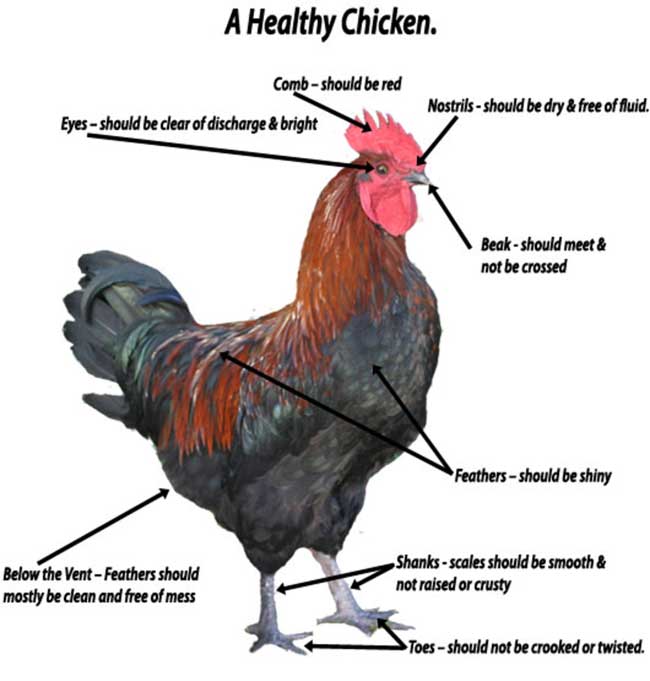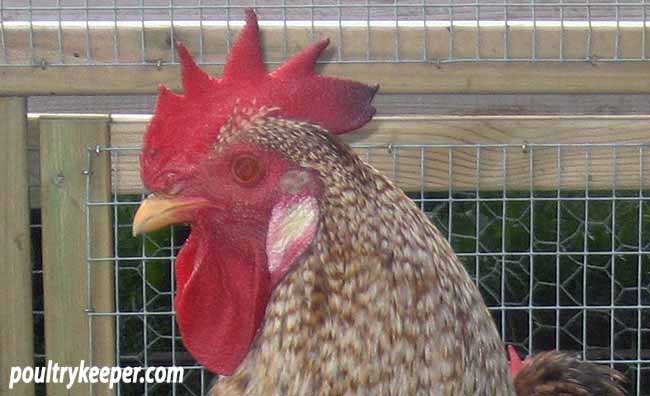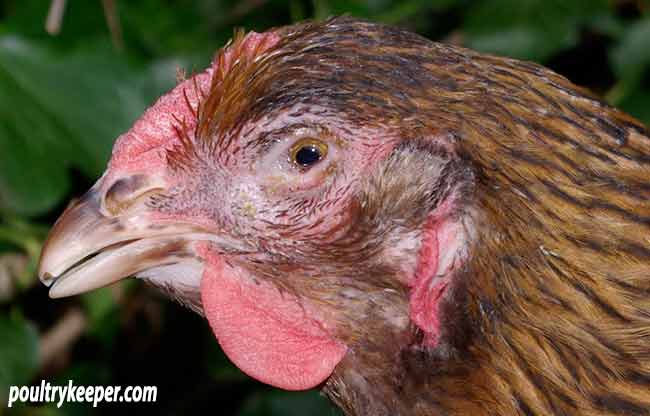It is important to learn how to inspect a chicken properly to assess it for good health.
Not only is a chicken’s health check important when buying hens but good husbandry involves checking your birds regularly for the first signs of problems so that they can be nipped in the bud.
Experienced poultry keepers develop a sixth sense for problems and a quick glance at the way their birds are behaving can tell them a lot but nothing beats a good inspection and examining every bird in the flock individually is the best way to keep on top of numerous problems.
The following diagram gives a few pointers of what to look out for:

General health
Healthy birds, whatever breed should look alert. Most of the time birds will be standing, they will sit down from time to time, especially in hot weather in the shade but expect healthy birds to be content, alert and not hunched up or fluffed up in any way.
A chicken that sits in a corner or appears to be drowsy should be treated suspiciously. A bird that is unwell is usually lethargic, hunched up with its head close to its body and is sitting away from the rest of the flock.
[note style=”alert” show_icon=”true”]Caution: Buying chickens at poultry auctions can be fraught with problems as many sellers can remain anonymous, passing off birds that are not fit and healthy. Most good auction organisers with experience of poultry will not allow sick birds to be sold but always inspect a bird for good health visually and if you can, physically before bidding.[/note]
Combs
Combs are a great indication to the heath of birds. A bright rich red comb usually indicates good health and in hens that she is in lay. A pink looking comb indicates she is not in lay but still healthy. A comb with a bluish tinge indicates poor blood circulation and should be treated with caution.

This Cream Legbar cock had a blue tinged comb. He survived for 3 weeks after this photo was taken before dying from a respiratory infection, probably brought on by an underlying disease.
Combs that are excessively scabbed probably mean a bird has been fighting. Cockerels kept in adjacent runs will still fight against the wire, injuring themselves but if you are looking to buy a bird to add to your flock, buying a bird that has been picked on, or fights can mean bad news.
You may also wish to assess the temperament of a cockerel before you buy him.
Feathers and vent
Inspect under feathers for parasites, especially under wings and around the vent. The most likely problems are lice (between the feathers) and scaly leg mites (in the scales of the legs making the scales protrude out).
Birds that are dirty, scruffy or have an excess of muck on their feathers around the vent area can be a sign of problems. Some of the more fluffy breeds will get some muck on their feathers but in general should keep themselves fairly clean.
Lice aren’t a show stopper but remember they will need dealing with. Scaly leg mites are harder to get rid
Eyes, nose, beak and toes
Have a look into the eyes of your birds. They should be clear, clean and bright. Bubbles or fluid around the corners of the eyes and / or fluid around the nostrils can indicate respiratory infections.
 Tell-tale bubbles in the corners of the eyes are a symptom of Mycoplasma Gallisepticum.
Tell-tale bubbles in the corners of the eyes are a symptom of Mycoplasma Gallisepticum.
Respiratory problems are common in chickens and a quick listen to your birds breathing and inspection inside the beak can soon tell you if there are problems in the upper respiratory tract. Listen for rattles or wheezing during breathing.
The upper and lower beak should meet in the middle and should not be crossed over. Toes should be straight. Bent toes are a deformity that is usually inherited and whilst birds with these are good pet birds, you should not breed from birds with such deformities.




